Sometimes, you choose your fly-fishing schedule. Sometimes, the schedule chooses you. I fished today during the Nor’easter.
With Real Life very busy these days, I don’t have many windows for fishing. I get what I get. So, with Saturday morning open, I had been looking forward to test-driving my micro-thin Euronymphing leader (prior post and formula here).
Unfortunately, I saw this weather forecast.
[Saturday Nor’Easter] Heavy rainfall, strong coastal winds and minor coastal flooding is expected from this storm. pic.twitter.com/S8Pl2Ymvqe
— NWS Boston (@NWSBoston) October 26, 2018
I decided to go for it. I figured the storm would keep away the crowds.
I decided to pressure-test the micro-thin leader and hit the most trafficked areas of the Swift River. When I started fly fishing in 2014, the Swift was a frequent target. Floating indicators and throwing dries was a fun way to get to know fly fishing.
Then, Swift River Burn Out settled in: the crowds, the trash, etc. When I do go to the Swift’s glamour stretches on the rare occasion these days, it is usually “dries or die.”
Moreover, I’ve never had good luck Euronymphing at the Swift’s busiest spots. The water is too slow or shallow, and the casting angles are not conducive. So, I figured Saturday would be a great opportunity. Does a super-thin leader really work, as UpCountry’s Torrey Collins has advised me? Will it be able to sense the super-quick takes of highly-pressured fish at the Swift’s glamour spots?
I arrived at the first spot before dawn. As soon as I could see a bit, I started to tightline small and light flies. My new leaders incorporate white Cortland indicator mono, and so, it was a cinch to see my sighter. I landed a brookie right away and thought that, perhaps, it was a stroke of good luck.
It was 36 °F, and my hands quickly felt numb and I lost finger dexterity. Fortunately, I had my winter gear in my car, as well as a ski hand-warmer.
I started to cover more water. The micro-thin leader was extremely sensitive. At one point, my sighter made a slight pause. I set the hook. A good-sized rainbow showed up. It was extremely beat up, as the high volume of anglers means that those fish definitely pay their dues.
Thinking that it was good luck, I kept fishing. Soon, this 17.5″ fish flopped into the net.
There weren’t many active trout, with the wind blowing and the rain really coming down. I floated indicators, too, for a change of pace, but didn’t get any takes. I then switched back to tightlining. I started running into more fish and landed a good number. This Franken-fish was a bit of a shock.
I moved to a new spot that featured slow water. I landed another rainbow, but, that was all. I saw some fish suspended and tried to dupe them by twitching and bouncing a Caddis dry with a Euro dry-dropper set-up. They looked but wouldn’t touch, unfortunately. Still, it was fun to see them react.
I moved to a third area. I decided to play with a drop-shot set-up, one fished with a size 20 soft hackle that did well in the morning.
Whether it was good luck, good timing or a good leader, I ran into a pile of rainbows. Takes were very subtle, but the micro-thin leader seemed to pick them up. The rainbows all looked the same: big, beautifully-colored, and clones of each other. This 17″ fish really fought well, leaping quite a few times. (The tiny fly is still on its lip in the photos.)
A quick outing stretched to eight hours because the action was so good. It ended up being a high-volume day. Maybe 18 or so takes and landed between 12 and 15?
Amazingly, there was a hot fly of the day. The CDC soft hackle, an innocuous-looking little gem.
I wolfed down some Thai food once I got back to town and en route to home. A 4:30 pm lunch, as I had not packed a meal, thinking it would be a short trip.
A serendipitous and good day. All I know is that I want to fish during the next Nor’easter.
Thin to win.
Discover more from BlogFlyFish.com
Subscribe to get the latest posts sent to your email.

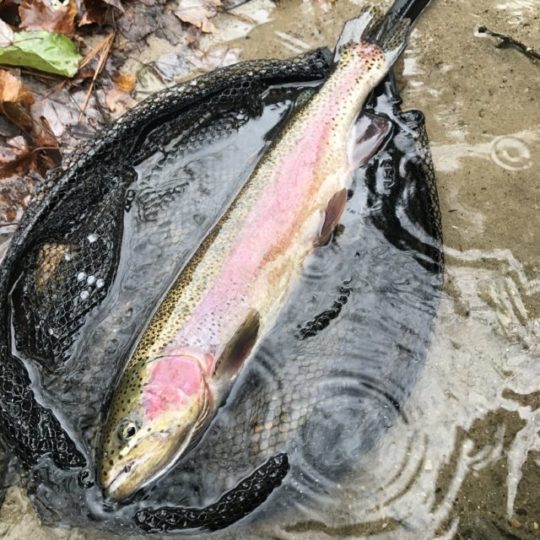

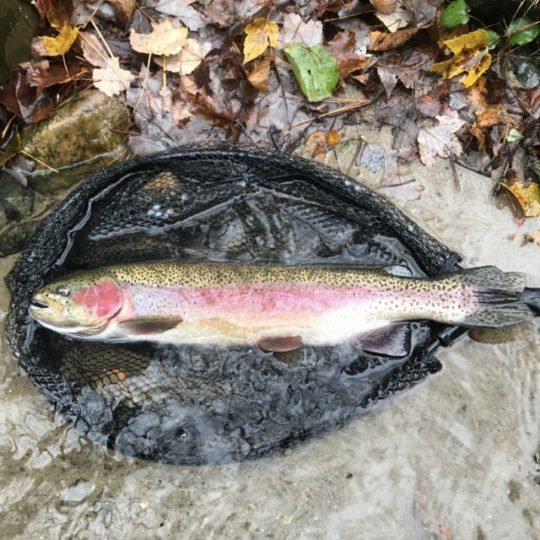
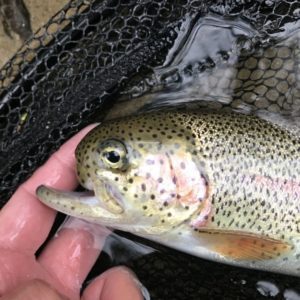

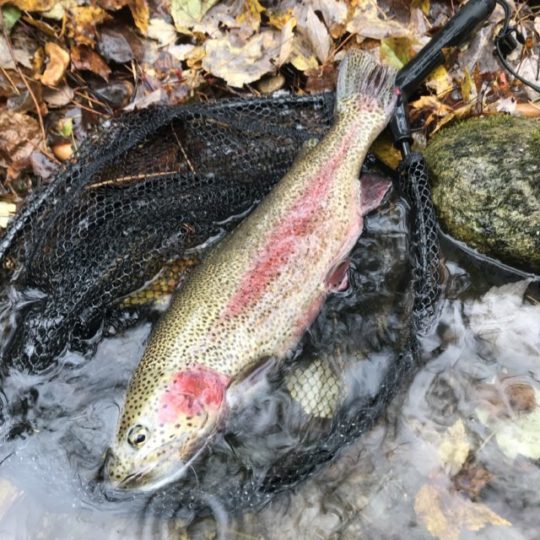
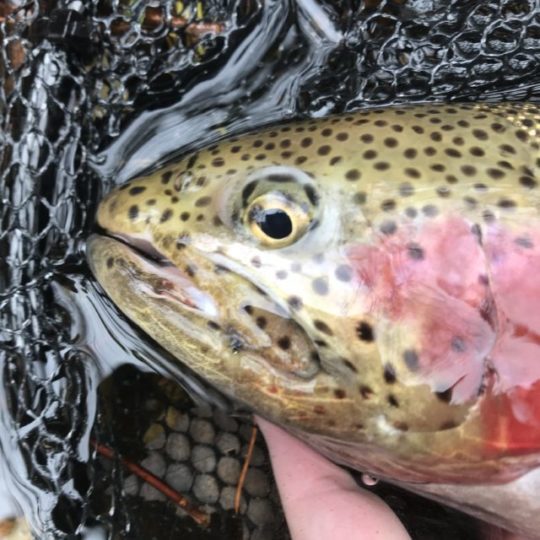
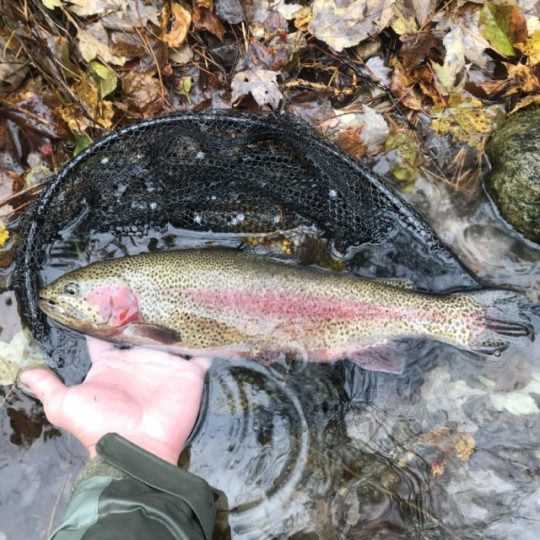


Hah. One of your fellow Blog Hosts recently posted that Euro-Nymphing doesn’t work on the Swift! You shredded that theory! GO SOX!
That had been my view, too. Maybe I went on the right day or the micro-thin leader made the difference.
Good move going on a lousy day. I would be worried about a tree falling on my head however.
That did cross my mind!
Enjoyed your post and congratulations on a great day fishing. I was wondering if you could clarify for me how you fish the CDC soft hackle when you are “tight lining”. Is it fished as a trailing fly behind a heavier nymph or is it higher up on the rig so it well off the bottom? Do you apply anything to the CDC to protect it from “slim” that happens after hooking a fish? Also could you describe how you rig and fish a “drop shot” setup? I’m relatively new to fly fishing and these techniques sound so effective I’d really like to understand them better. Many thanks.
Hi Harvey:
I fished the soft hackle off a dropper tag above the anchor fly.
I don’t put anything on the fly before fishing it sub-surface.
The drop-shot rig I used was my Euro leader. I clipped off the anchor fly, and I tied an overhand knot at the terminal end of the tippet to prevent the split shot from sliding off. I kept on the #20 soft hackle and just fished that. (The Euro leader is pretty versatile, allowing me to throw indicators, dry-droppers, short-line and long-line while tightlining, swing streamers, and now, drop-shot.)
Of course, you can drop-shot with a regular fly-line set-up. Examples: here and here.
Hope that helps.
We’re you able to do all those different techniques with your micro thin leader?
Yes
Based on your experience, would you say that drop shotting is more efficient, generally, than Euro nymphing with a micro-leader (for example, if you were in a comp and could fish either style, but you couldn’t switch back and forth).